Charles E W Bean, Diaries, AWM38 3DRL 606/274A/1 - 1918 - 1941 - Part 3
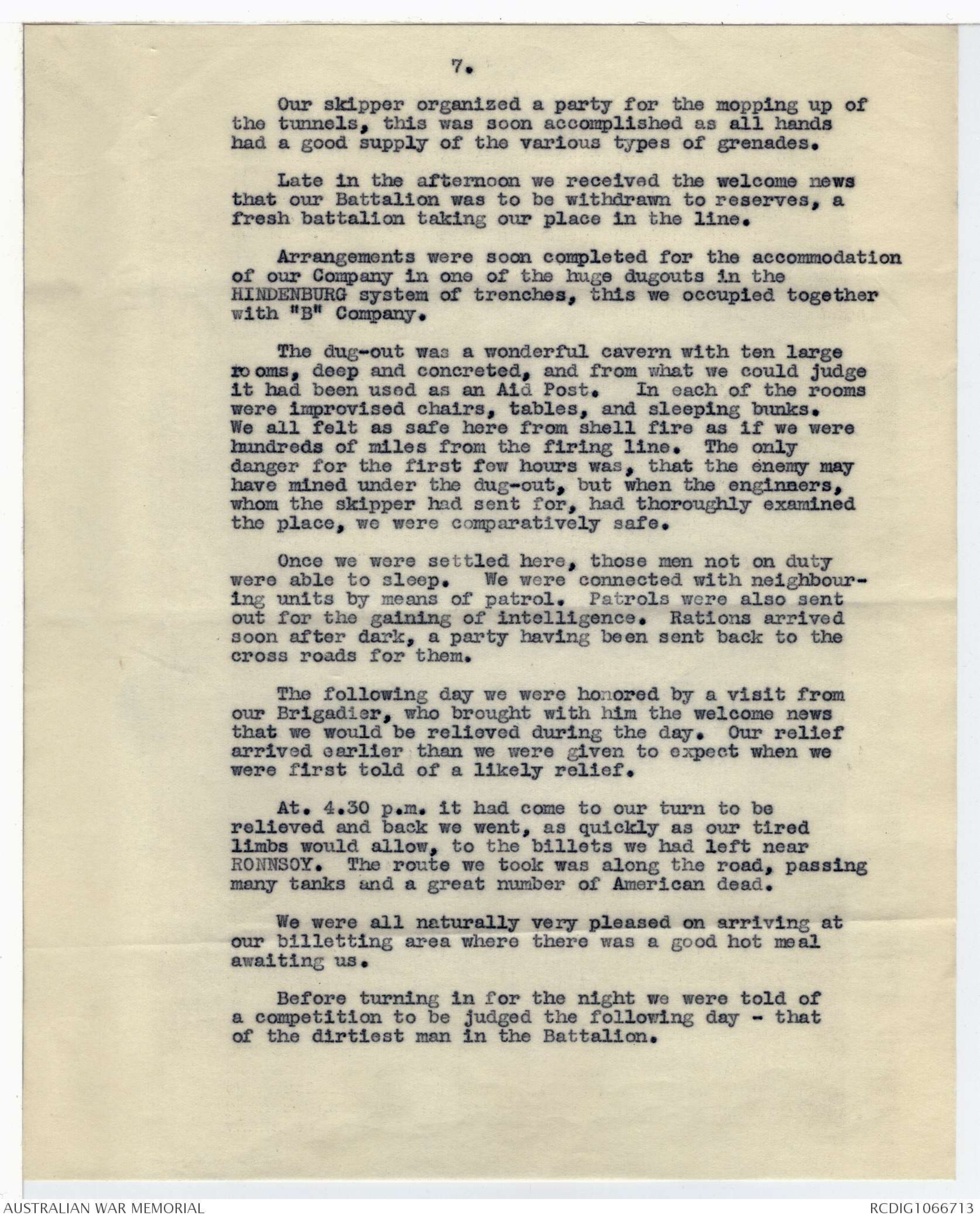
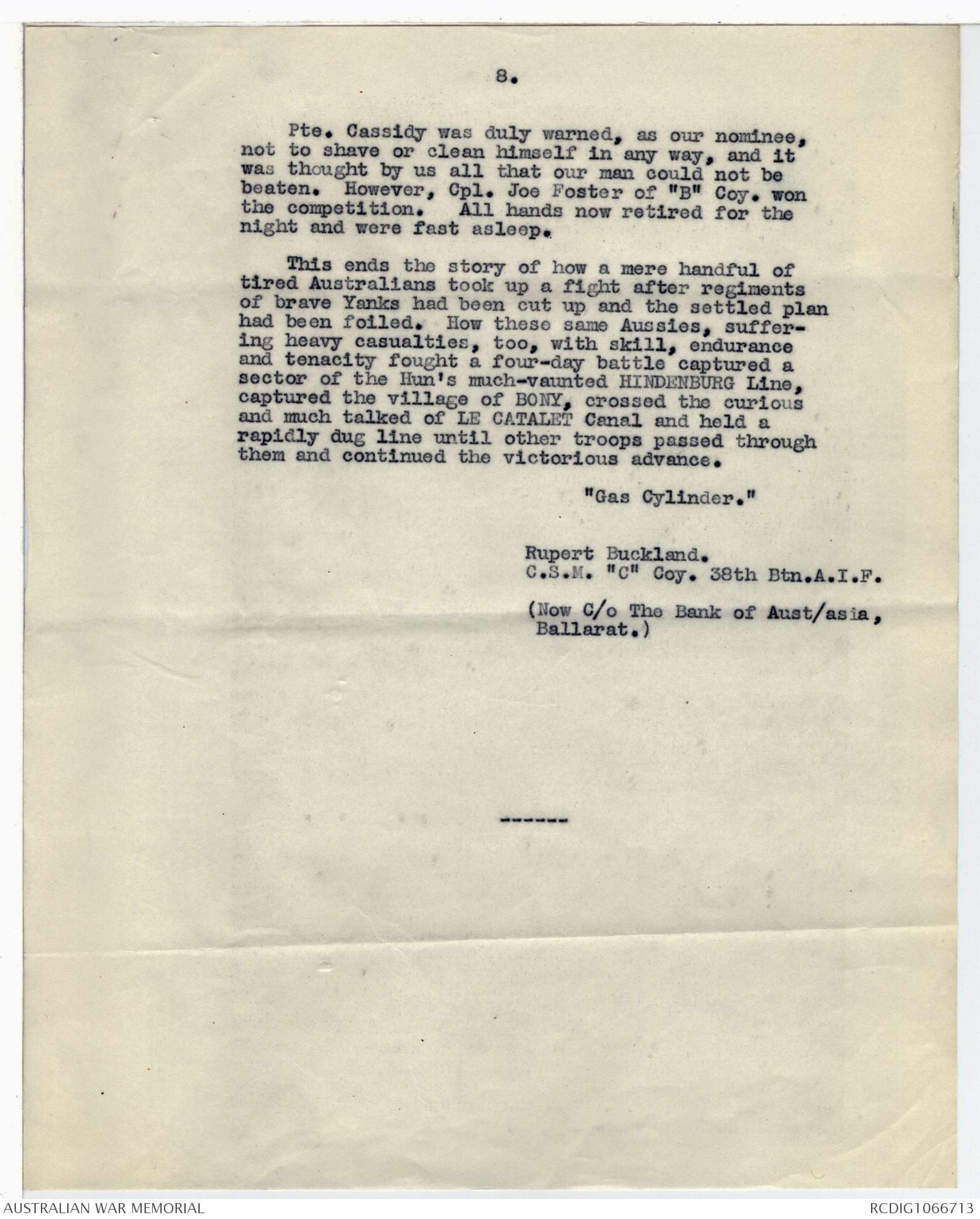
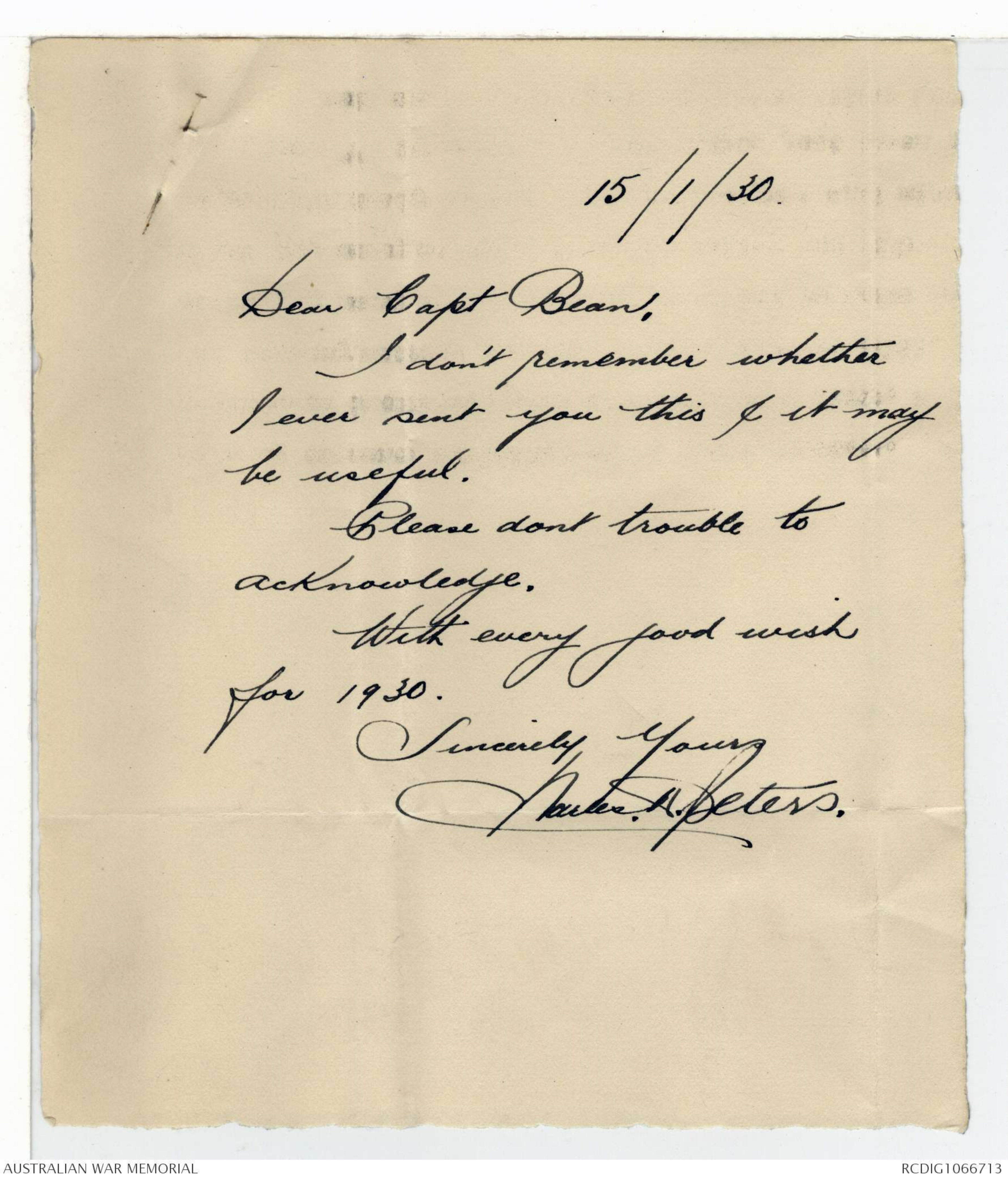
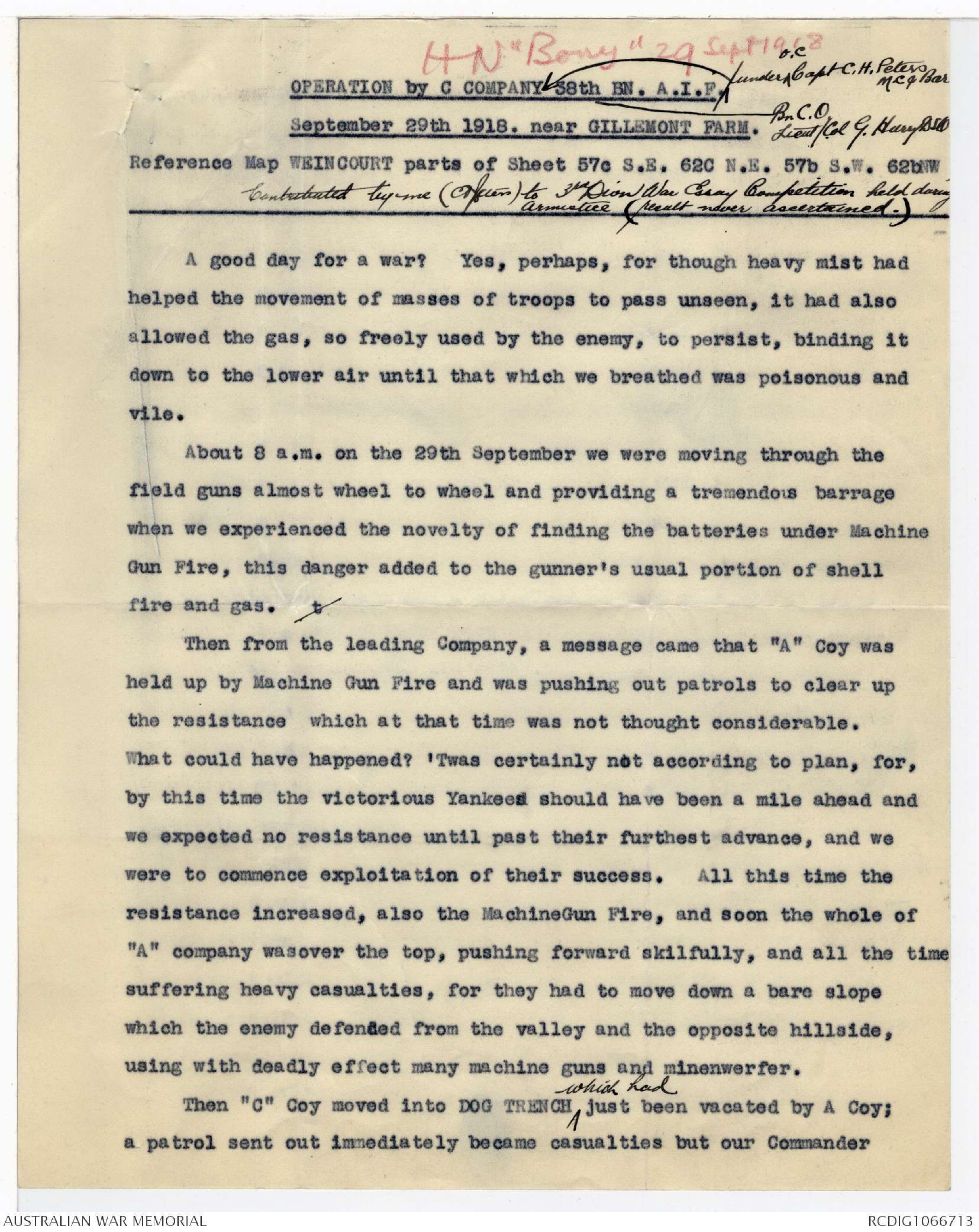
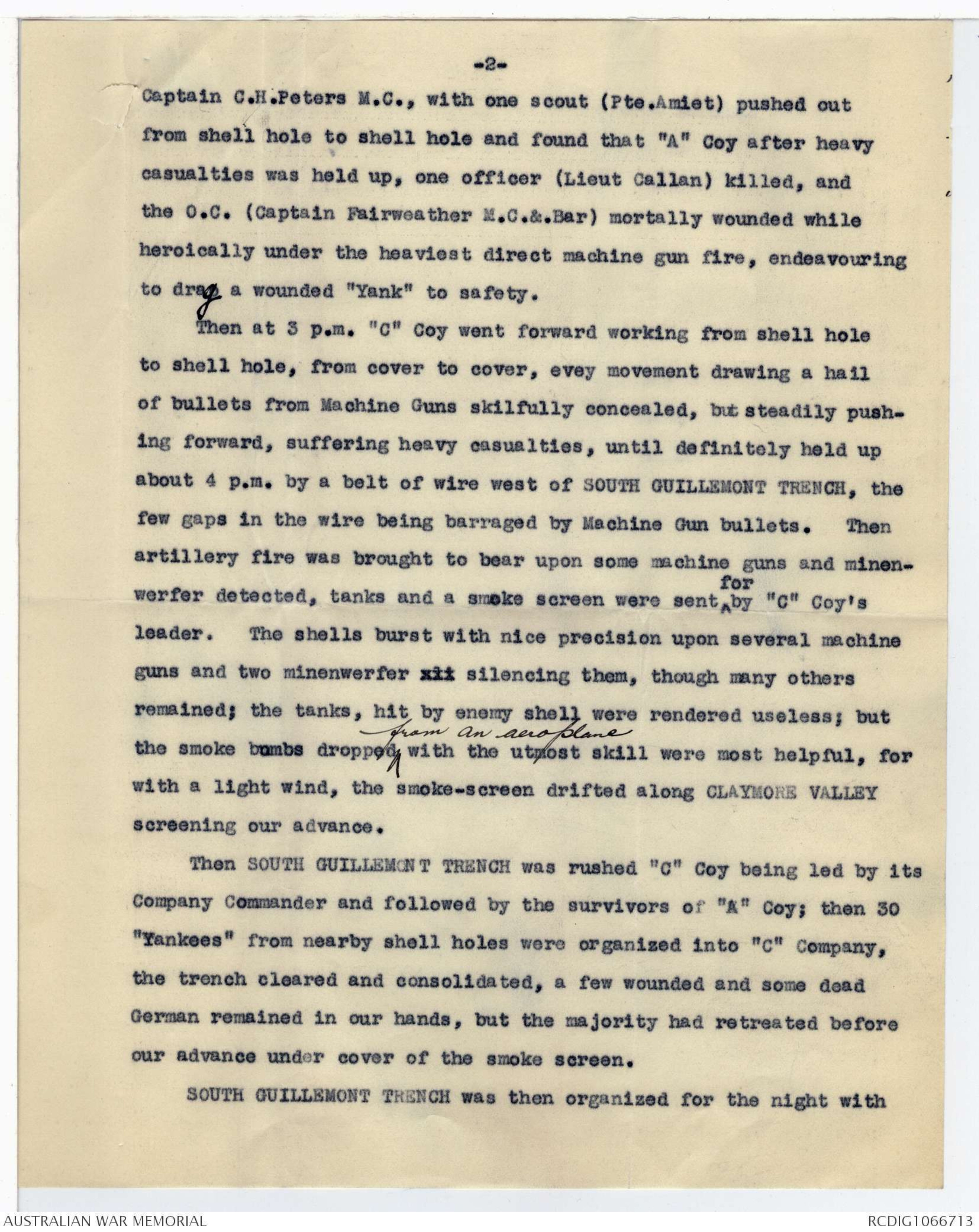
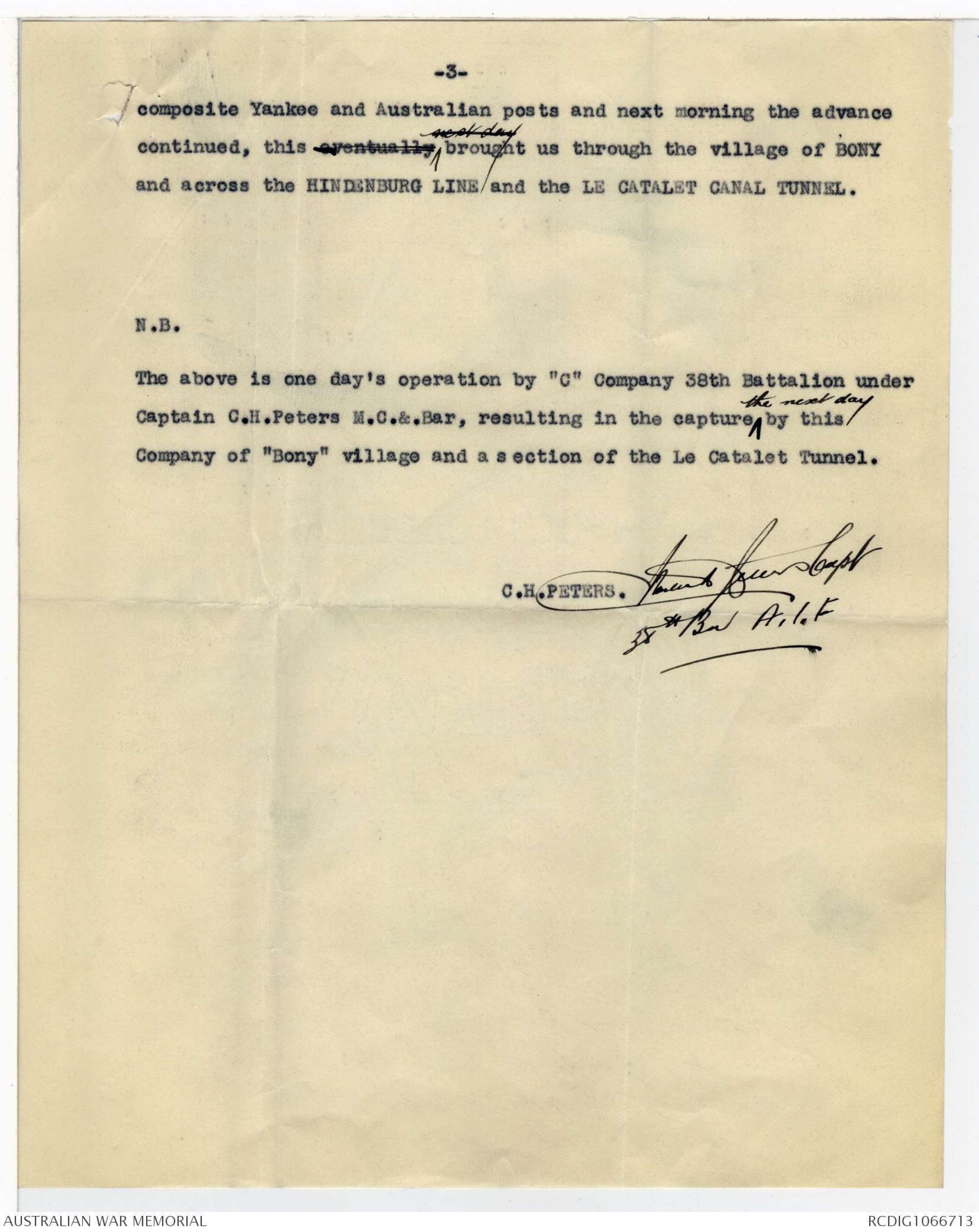
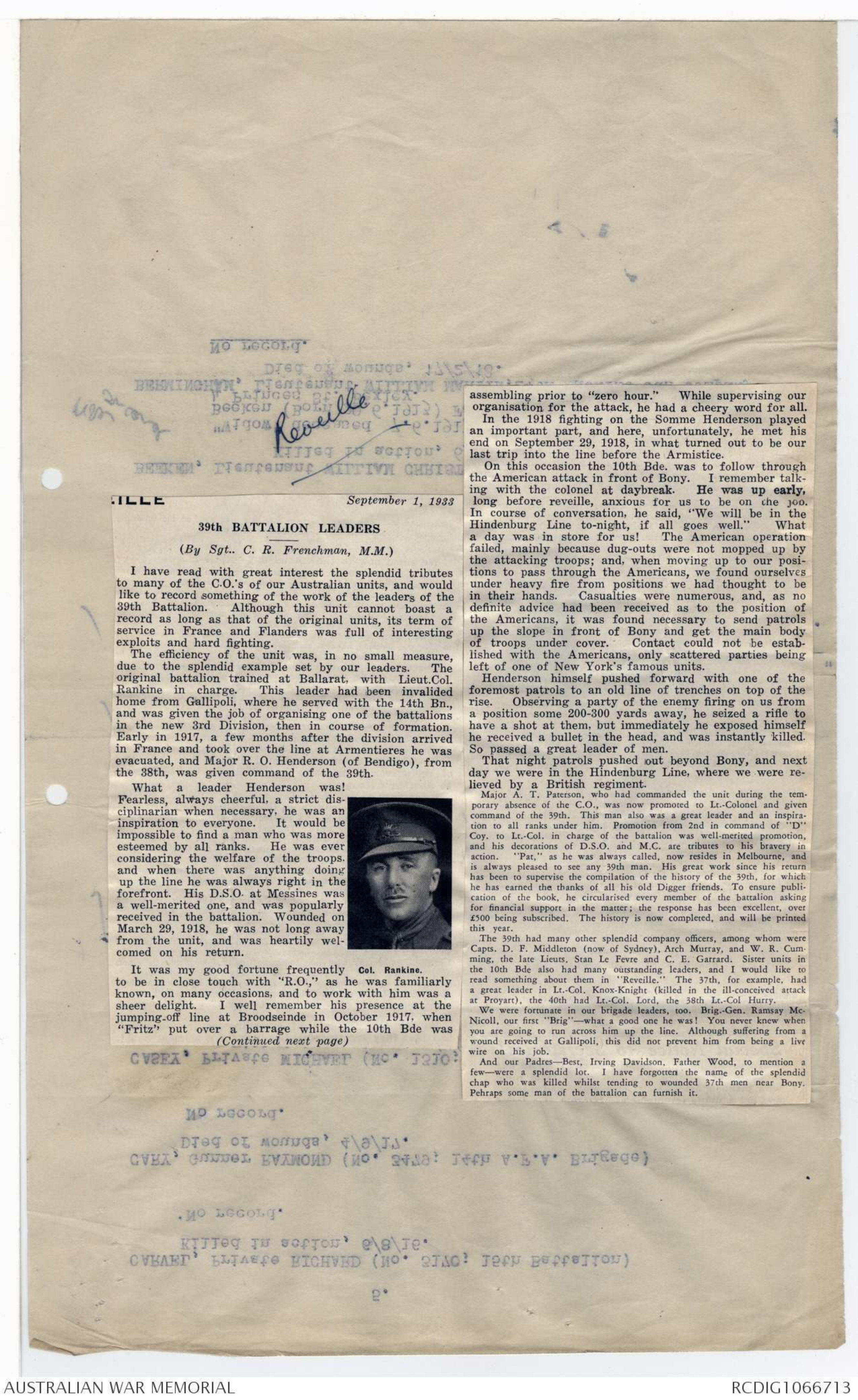
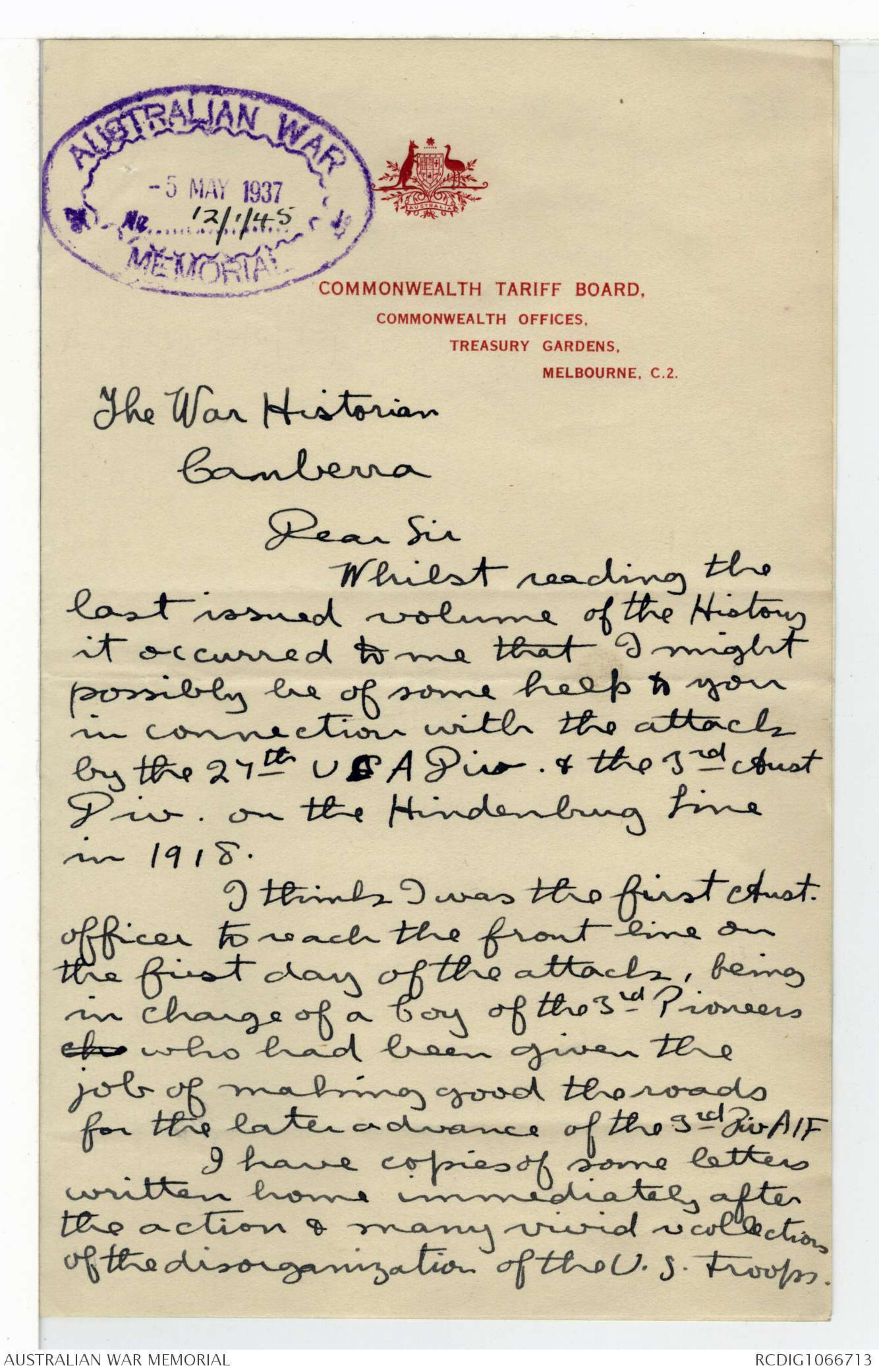
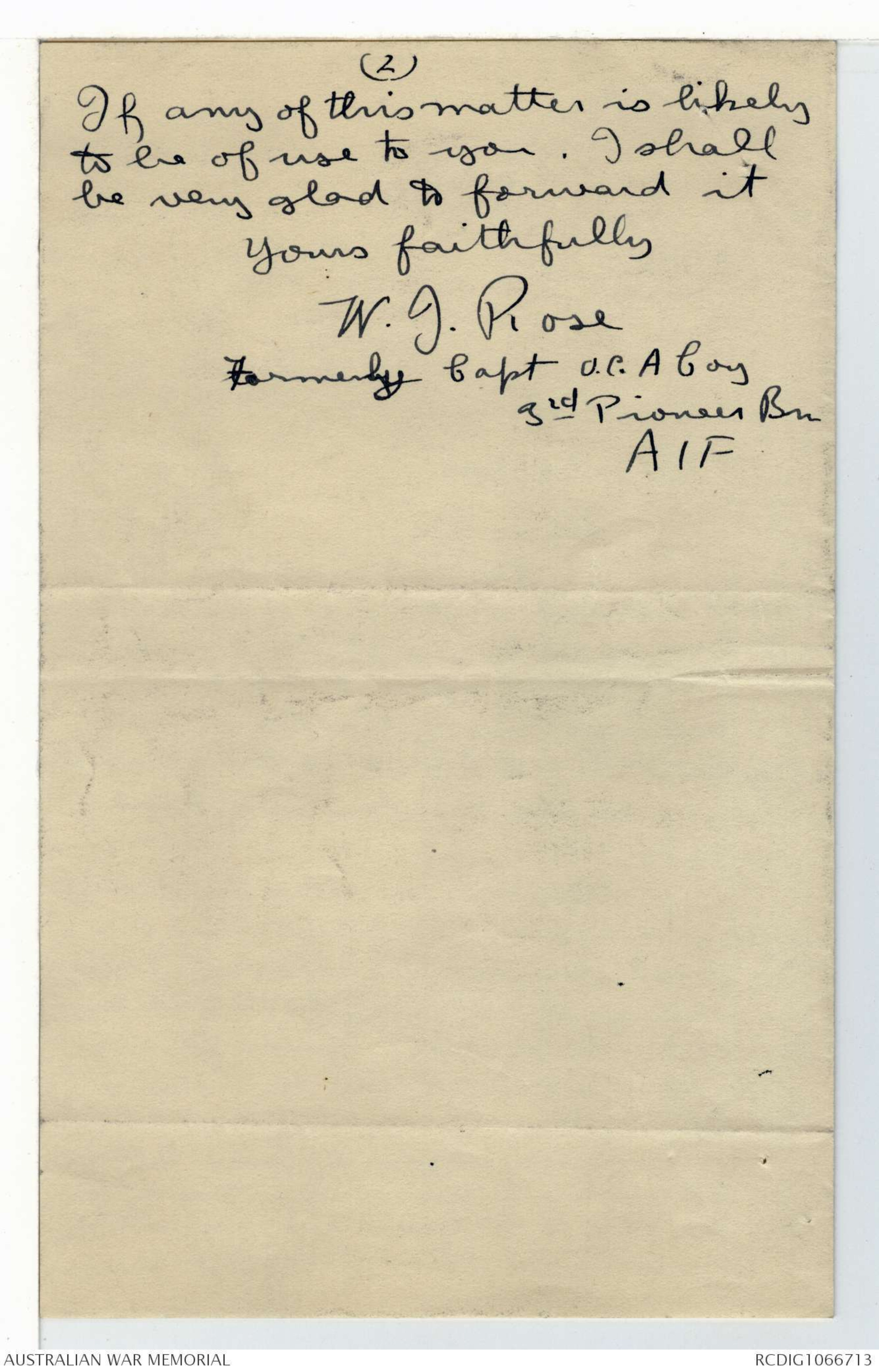
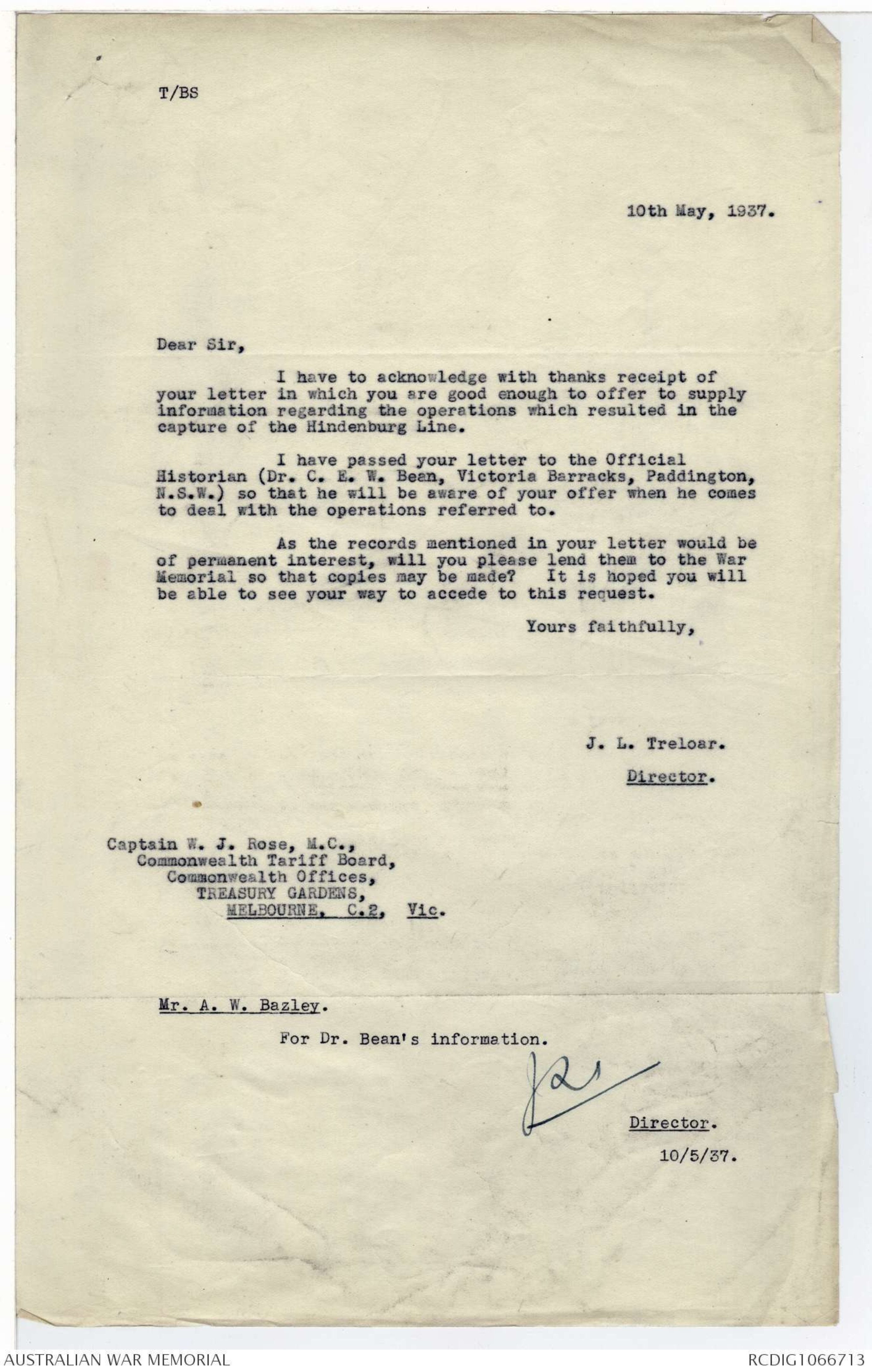
7.
Our skipper organized a party for the mopping up of
the tunnels, this was soon accomplished as all hands
had a good supply of the various types of grenades.
Late in the afternoon we received the welcome news
that our Battalion was to be withdrawn to reserves, a
fresh battalion taking our place in the line.
Arrangements were soon completed for the accommodation
of our Company in one of the huge dugouts in the
HINDENBURG system of trenches, this we occupied together
with "B" Company.
The dug-out was a wonderful cavern with ten large
rooms, deep and concreted, and from what we could judge
it had been used as an Aid Post. In each of the rooms
were improvised chairs, tables, and sleeping bunks.
We all felt as safe here from shell fire as if we were
hundreds of miles from the firing line. The only
danger for the first few hours was, that the enemy may
have mined under the dug-out, but when the engineers
whom the skipper had sent for, had thoroughly examined
the place, we were comparatively safe.
Once we were settled here, those men not on duty
were able to sleep. We were connected with neighbouring
units by means of patrol. Patrols were also sent
out for the gaining of intelligence. Rations arrived
soon after dark, a party having been sent back to the
cross roads for them.
The following day we were honored by a visit from
our Brigadier, who brought with him the welcome news
that we would be relieved during the day. Our relief
arrived earlier than we were given to expect when we
were first told of a likely relief.
At. 4.30 p.m. it had come to our turn to be
relieved and back we went, as quickly as our tired
limbs would allow, to the billets we had left near
RONNSOY. The route we took was along the road, passing
many tanks and a great number of American dead.
We were all naturally very pleased on arriving at
our billetting area where there was a good hot meal
awaiting us.
Before turning in for the night we were told of
a competition to be judged the following day - that
of the dirtiest man in the Battalion.
8.
Pte. Cassidy was duly warned, as our nominee,
not to shave or clean himself in any way, and it
was thought by us all that our man could not be
beaten. However, Cpl. Joe Foster of "B" Coy. won
the competition. All hands now retired for the
night and were fast asleep.
This ends the story of how a mere handful of
tired Australians took up a fight after regiments
of brave Yanks had been cut up and the settled plan
had been foiled. How these same Aussies, suffering
heavy casualties, too, with skill, endurance
and tenacity fought a four-day battle captured a
sector of the Hun's much-vaunted HINDENBURG Line,
captured the village of BONY, crossed the curious
and much talked of LE CATALET Canal and held a
rapidly dug line until other troops passed through
them and continued the victorious advance.
"Gas Cylinder."
Rupert Buckland.
C.S.M. "C" Coy. 38th Btn. A.I.F.
(Now C/o The Bank of Aust/asia,
Ballarat.)
15/1/30
Dear Capt Bean,
I don't remember whether
I ever sent you this & it may
be useful.
Please dont trouble to
acknowledge
With every good wish
for 1930.
Sincerely Yours
Charles H. Peters.
[*H N "Bony" 29 Sept 1918*]
OPERATION by C COMPANY ^under ^O.C Capt. C.H. Peters M.C. & Bar 38th Bn C.O. Lieut/Col G. Hurry D.S.O. A.I.F.
September 29th 1918. near GILLEMONT FARM.
Reference Map WEINCOURT parts of Sheet 57c S.E. 62C N.E. 57b S.W. 62bNW
Contributed by me (C.H. Peters) to 3rd Divn War Esssay Competition held during
Armistice (result never ascertained.)
A good day for a war? Yes, perhaps, for though heavy mist had
helped the movement of masses of troops to pass unseen, it had also
allowed the gas, so freely used by the enemy, to persist, binding it
down to the lower air until that which we breathed was poisonous and
vile.
About 8 a.m. on the 29th September we were moving through the
field guns almost wheel to wheel and providing a tremendous barrage
when we experienced the novelty of finding the batteries under Machine
Gun Fire, this danger added to the gunner's usual portion of shell
fire and Gas. t.
Then from the leading Company, a message came that "A" Coy was
held up by Machine Gun Fire and was pushing out patrols to clear up
the resistance which at that time was not thought considerable.
What could have happened? 'Twas certainly not according to plan, for,
by this time the victorious Yankees should have been a mile ahead and
we expected no resistance until past their furthest advance, and we
were to commence exploitation of their success. All this time the
resistance increased, also the MachineGun Fire, and soon the whole of
"A" company wasover the top, pushing forward skilfully, and all the time
suffering heavy casualties, for they had to move down a bare slope
which the enemy defended from the valley and the opposite hillside,
using with deadly effect many machine guns and minenwerfer.
Then "C" Coy moved into DOG TRENCH ^which had just been vacated by A Coy;
a patrol sent out immediately became casualties but our Commander
-2-
Captain C.H.Peters M.C., with one scout (Pte.Amiet) pushed out
from shell hole to shell hole and found that "A" Coy after heavy
casualties was held up, one officer (Lieut Callan) killed, and
the O.C. (Captain Fairweather M.C.&.Bar) mortally wounded while
heroically under the heaviest direct machine gun fire, endeavouring
to drag a wounded "Yank" to safety.
Then at 3 p.m. "C" Coy went forward working from shell hole
to shell hole, from cover to cover, evey movement drawing a hail
of bullets from Machine Guns skilfully concealed, but steadily pushing
forward, suffering heavy casualties, until definitely held up
about 4 p.m. by a belt of wire west of SOUTH GUILLEMONT TRENCH, the
few gaps in the wire being barraged by Machine Gun bullets. Then
artillery fire was brought to bear upon some machine guns and minenwerfer
detected, tanks and a smoke screen were sent ^for by "C" Coy's
leader. The shells burst with nice precision upon several machine
guns and two minenwerfer xxx silencing them, though many others
remained; the tanks, hit by enemy shell were rendered useless; but
the smoke bombs dropped ^from an aeroplane with the utmost skill were most helpful, for
with a light wind, the smoke-screen drifted along CLAYMORE VALLEY
screening our advance.
Then SOUTH GUILLEMONT TRENCH was rushed "C" Coy being led by its
Company Commander and followed by the survivors of "A" Coy; then 30
"Yankees" from nearby shell holes were organized into "C" Company,
the trench cleared and consolidated, a few wounded and some dead
German remained in our hands, but the majority had retreated before
our advance under cover of the smoke screen.
SOUTH GUILLEMONT TRENCH was then organized for the night with
-3-
composite Yankee and Australian posts and next morning the advance
continued, this eventually ^next day brought us through the village of BONY
and across the HINDENBURG LINE and the LE CATALET CANAL TUNNEL.
N.B.
The above is one days operation by "C" Company 38th Battalion under
Captain C.H.Peters M.C.&.Bar, resulting in the capture ^the next day by this
Company of "Bony" village and a section of the Le Catalet Tunnel.
C.H.PETERS. Charles Peters Capt
38th Bn A.I.F.
Reveille
September 1, 1933
39th BATTALION LEADERS
(By Sgt., C. R. Frenchman, M.M.)
I have read with great interest the splendid tributes
to many of the C.O.s of our Australian units, and would
like to record something of the work of the leaders of the
39th Battalion. Although this unit cannot boast a
record as long as that of the original units, its term of
service in France and Flanders was full of interesting
exploits and hard fighting.
The efficiency of the unit was, in no small measure
due to the splendid example set by our leaders. The
original battalion trained at Ballarat, with Lieut. Col.
Rankine in charge. This leader had been invalided
home from Gallipoli, where he served with the 14th Bn.,
and was given the job of organising one of the battalions
in the new 3rd Division, then in course of formation.
Early in 1917, a few months after the division arrived
in France and took over the line at Armentieres he was
evacuated, and Major R. O. Henderson (of Bendigo), from
the 38th, was given command of the 39th.
What a leader Henderson was!
Fearless, always cheerful, a strict disciplinarian
when necessary, he was an
inspiration to everyone. It would be
impossible to find a man who was more
esteemed by all ranks. He was ever
considering the welfare of the troops,
and when there was anything doing
up the line he was always right in the
forefront. His D.S.O. at Messines was
a well-merited one, and was popularly
received in the battalion. Wounded on
March 29, 1918, he was not long away
from the unit, and was heartily welcomed
on his return.
Photograph - see original document
Col. Rankine.
It was my good fortune frequently
to be in close touch with "R.O.," as he was familiarly
known, on many occasions, and to work with him was a
sheer delight. I well remember his presence at the
jumping-off line at Broodseinde in October 1917, when
"Fritz" put over a barrage while the 10th Bde was
(Continued next page)
assembling prior to "zero hour." While supervising our
organisation for the attack, he had a cheery word for all.
in the 1918 fighting on the Somme Henderson played
an important part, and here, unfortunately, he met his
end on September 29, 1918, in what turned out to be our
last trip into the line before the Armistice.
On this occasion the 10th Bde. was to follow through
the American attack in front of Bony. I remember talking
with the colonel at daybreak. He was up early,
long before reveille, anxious for us to be on the job.
In course of conversation, he said, "We will be in the
Hindenburg Line to-night, if all goes well." What
a day was in store for us! The American operation
failed, mainly because dug-outs were not mopped up by
the attacking troops; and, when moving up to our positions
to pass through the Americans, we found ourselves
under heavy fire from positions we had thought to be
in their hands. Casualties were numerous, and, as no
definite advice had been received as to the position of
the Americans, it was found necessary to send patrols
up the slope in front of Bony and get the main body
of troops under cover. Contact could not be established
with the Americans, only scattered parties being
left of one of New York's famous units.
Henderson himself pushed forward with one of the
foremost patrols to an old line of trenches on top of the
rise. Observing a party of the enemy firing on us from
a position some 200-300 yards away, he seized a rifle to
have a shot at them, but immediately he exposed himself
he received a bullet in the head, and was instantly killed.
So passed a great leader of men.
That night patrols pushed put beyond Bony, and next
day we were in the Hindenburg Line, where we were relieved
by a British regiment.
Major A. T. Paterson, who had commanded the unit during the temporary
absence of the C.O., was now promoted to Lt.-Colonel and given
command of the 39th. This man also was a great leader and an inspiration
to all ranks under him. Promotion from 2nd in command of "D"
Coy. to Lt.-Col. in charge of the battalion was a well-merited promotion,
and his decorations of D.S.O. and M.C. are tributes to his bravery is
action. "Pat," as he was always called, now resides in Melbourne, and
is always pleased to see any 39th man. His great work since his return
has been to supervise the compilation of the history of the 39th, for which
he has earned the thanks of all his old Digger friends. To ensure publication
of the book, he circularised every member of the battalion asking
for financial support in the matter; the response has been excellent, over
£500 being subscribed. The history is now completed, and will be printed
this year.
The 39th had many other splendid company officers, among whom were
Capts. D. F. Middleton (now of Sydney), Arch Murray, and W. R. Cumming,
the late Lieuts, Stan Le Fevre and C. E. Garrard. Sister units in
the 10th Bde also had many outstanding leaders, and I would like to
read something about them in "Reveille." The 37th, for example, had
a great leader in Lt.-Col. Knox- Knight (killed in the ill-conceived attack
at Proyart), the 40th had Lt.-Col. Lord, the 38th Lt.-Col Hurry.
We were fortunate in our brigade leaders, too. Brig.-Gen. Ramsay McNicoll,
our first "Brig" —what a good one he was! You never knew when
you are going to run across him up the line. Although suffering from a
wound received at Gallipoli, this did not prevent him from being a live
wire on his job.
And our Padres—Best, Irving Davidson, Father Wood, to mention a
few—were a splendid lot. I have forgotten the name of the splendid
chap who was killed whilst tending to wounded 37th men near Bony.
Pehraps some man of the battalion can furnish it.
[*AUSTRALIAN WAR
-5 MAY 1937
12/1/45
MEMORIAL*]
COMMONWEALTH TARIFF BOARD,
COMMONWEALTH OFFICES,
TREASURY GARDENS,
MELBOURNE. C.2.
The War Historian
Canberra
Dear Sir
Whilst reading the
last issued volume of the History
it occurred to me that I might
possibly be of some help to you
in connection with the attack
by the 27th USA Div. & the 3rd Aust
Div. on the Hindenberg Line
in 1918.
I think I was the first Aust.
officer to reach the front line on
the first day of the attacks, being
in charge of a Coy of the 3rd Pioneersch who had been given the
job of making good the roads
for the later advance of the 3rd Div AIF
I have copies of some letters
written home immediately after
the action & many vivid recollections
of the disorganization of the U.S. troops.
(2)
If any of this matter is likely
to be of use to you. I shall
be very glad to forward it
Yours faithfully
W.J. Rose
Formerly Capt O.C. A Coy
3rd Pioneer Bn
AIF
T/BS
10th May, 1937.
Dear Sir,
I have to acknowledge with thanks receipt of
your letter in which you are good enough to offer to supply
information regarding the operations which resulted in the
capture of the Hindenburg Line.
I have passed your letter to the Official
Historian (Dr. C. E. W. Bean, Victoria Barracks, Paddington,
N.S.W.) so that he will be aware of your offer when he comes
to deal with the operations referred to.
As the records mentioned in your letter would be
of permanent interest, will you please lend them to the War
Memorial so that copies may be made? It is hoped you will
be able to see your way to accede to this request.
Yours faithfully,
J. L. Treloar.
Director.
Captain W. J. Rose, M.C.
Commonwealth Tariff Board,
Commonwealth Offices,
TREASURY GARDENS,
MELBOURNE, C.2, Vic.
Mr. A. W. Bazley.
For Dr. Bean's information.
JLT
Director.
10/5/37.
 Sam scott
Sam scottThis transcription item is now locked to you for editing. To release the lock either Save your changes or Cancel.
This lock will be automatically released after 60 minutes of inactivity.